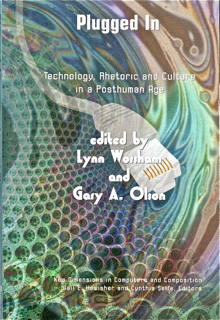Plugged In: Technology, Rhetoric and Culture in a Posthuman Age Edited by Lynn Worsham and Gary A. Olson (2008)
Part 1: Cyberbodies in a Posthuman Age
In "Cybernetics, Ethos, and Ethics: the Plight of the Bread-and-Butter-Fly," Kristie S. Fleckenstein takes Lewis Carroll’s description of the bread-and-butter-fly as an allegory for a perpetual state of boundary confusion and loss of bodily integrity through network interfaces. This boundary confusion is problematic for a classical conception of ethos predicated upon an original, autonomous, and temporally located authorial presence. Fleckenstein’s neologism, "cyberethos," articulates a theory of nonlinear cause and effect that "provide[s] a robust framework [...] to take responsibility for embeddedness of good character within a material context permeated by [the] nonlinear time" of cybernetics (p. 5). Cybernetics, she maintains, is a theory that any entity (both machine and human) "is constituted and reconstituted" by its transacting flows of information (p. 6). Information flows are potentially infinite, yet what passes through our finite sorting filers is a difference in values for the particular system of immersion. For Fleckenstein, the elements of prudence, virtue, and good necessarily pre-exist classical ethos in order that they be "identified as significant" (p. 7).As users are unable to an example of good character independent of the system of difference that enables their perception of the difference, Fleckenstein’s groundwork will likely provide a crucial starting place for non-metaphysical cyberethical considerations in the future.
"We do not see a world 'out there' that exists apart from us. Rather, we see only what our systemic organization allows us to see. The environment triggers changes determined by the system's own structural properties. Thus the center of interest for autopoiesis shifts from the cybernetics of the observed system to the cybernetics of the observers ... the emphasis is now on the mutually constitutive interactions between the components of the system rather than on message, signal, or information. Indeed, one could say either that information does not exist in this paradigm or that it has sunk so deeply into the system as to become indistinguishable from the organizational properties defining the system as such." ~ N. Katherine Hayles |
|---|
Where Fleckenstein maps ethical immanence and cyber systems, Jennifer Bay's article, "Screening (In)Formation: Bodies and Writing in Network Culture," examines the body and screen as a specific site of ecological interactions. Far from materially bounded and subject to the user’s autonomous instrumentalization, Bay argues that they form a "complex, co-adaptive situation of inscription that transforms" both the local scene of writing and the "global level of bodies networking" (p. 27, 26). The body's boundary limits are both reflected and refracted by the screen through a Lacanian technological mirror (screen) stage, or through the concealment of inner hardware of actual processes. Drawing a corporeal analogy from screen to skin as the initial information-collecting boundary of self-formation, Bay explores the representative anecdote of digital skins such as avatars or personal graphical layerings for media use as an explicit site of the screen tensions. Echoing Deleuze's notions of assemblages and rhizomes, Bay encourages us to see our bodies as conduits of information continually re-territorialized by screens that we interact with. Her arguments will have special resonance with future shifts to wireless communications wherein new and unpredictable mergers between bodies and screens will arise.
Stanley Harrison’s, "Our Cyberbodies, Ourselves: Conceptual Grounds for Teaching Commodies to Write" complements the productive boundary elisions that Bay and Fleckenstein identify. He reminds us that discussions of the libratory potential of technology must account for the more insidious influences that constitute students-as-cyborgs and as "living commodities" (p. 43). Adding to Haraway's theory of cyborg writing, Harrison observes, "the power to survive, which is at the heart of cyborg writing, seems less about 'seizing the tools' [that mark the world that marked them as other]" than about the co-optation of the Will to "purchase the commodity self" though constant software and hardware upgrades (p. 43). His "class-inflected cyborg analysis" works toward "theorizing that stresses the power of commercially organized and proliferated computer writing spaces to penetrate and utterly transform the computer user at the point of interface" (p. 46). In the writing classroom, Harrison encourages tasks that prompt self-reflexive heuristic recognition for new media writers that make them aware of their identities as consumers.

